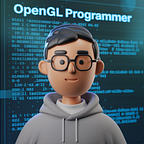Animating Your OpenGL Scene: Basic Movement and Rotation
Welcome back to our OpenGL journey! So far, we’ve learned how to draw shapes and move them around using input from the keyboard and mouse. Now, it’s time to add some excitement to our scenes by making those shapes move and rotate on their own! In this post, we’ll explore how to animate your OpenGL scene, so your shapes can come to life.
What is Animation in OpenGL?
Animation is all about making things move or change over time. In OpenGL, animation can be as simple as moving a square across the screen or as complex as spinning a 3D model. When we animate, we update our scene frame by frame, making small changes each time to create the illusion of movement.
Think of it like a flipbook. Each page shows a picture that’s slightly different from the last one. When you flip through the pages quickly, the pictures look like they’re moving!
Setting Up Basic Movement
Let’s start with something simple: moving a shape from one side of the screen to the other. We’ll use a variable to keep track of the shape’s position, and we’ll update that position a little bit each frame to make it move.
Here’s an example in C++ using OpenGL and GLUT:
